Introduction

We flew with KLM (www.klm.com) from Newcastle to Amsterdam and then onto Lyon on 11th June 2005 at a cost of £168 each. We then picked up a hire car from Europcar costing £203 for two weeks (www.europcar.com) at Lyon Airport and drove 80km to Chambery, a beautiful medieval town on the western edge of the Alps. We stayed at the excellent but inexpensive Hotel des Princes (£89 for a double room and breakfast for two nights) in the heart of the city.
Chambery and surrounds
On the morning of the 12th we had a short walk around the town, including several small parks. These yielded Serin, Swift, House Martin, Black Redstart and Spotted Flycatcher.
Later in the morning we drove north through Aix-le-Bains, along Lac de Borget to the marsh and floodplain forest at the north end of the lake.
This includes the Canal de Saviere, where Nightingale, Blackcap, Garden Warbler and Melodious Warbler sang in the woodland and willow scrub bordering the canal. We headed slightly further north to Mollard-Dessus, walking west to the banks of the River Rhone.
This powerful stretch of river was very quiet with few waterfowl. Black Kites and Goosander were viewed.
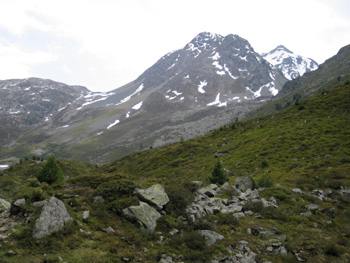
In the morning of the 13th we drove another 70km east to an apartment in the ski resort of Meribel-Mottaret. The resort lies at 1800 metres at the edge of the Vanoise National Park, designated for it’s high alpine habitats. The resort also lies on the edge of the Tueda Nature Reserve, where skiing is prohibited. This has ensured the reserve has retained a great range of habitats, including the largest area of Arolla Pine in the French Alps. The resort and all its amenities were deserted, only opening for the summer season in July. We found our apartment at www.hiddenlimits.co.uk
Week 1 Merribel–Mottaret
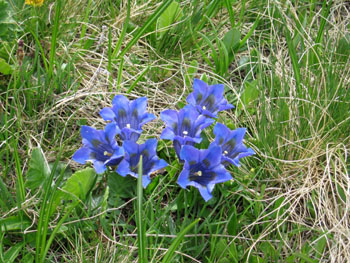
Black Redstart, Buzzard, Dipper, White Wagtail, Tree Pipit, Crag Martin and Redpoll were all present around the chalet. Over the next four days we walked from our valley bottom apartment onto several of the surrounding ridges.
Walking west in dreadful weather to the Roc de Tougne gave views of male and female Black Grouse, Water Pipit, Ring Ouzel and Northern Wheatear.
Heading east up to the summit of La Sauliere (a long but well surfaced climb of 1000 metres to 2700 metres) gave us great views of several approachable parties of Snowfinch, often viewed down to 20 feet. 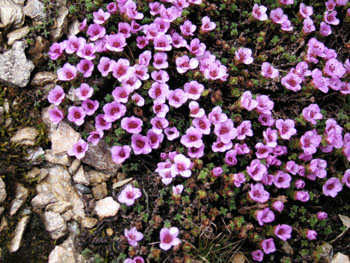 Several of these birds were gathering insects in the pastures before flying up to summit crags where they nested. Two male singing Rock Thrush were viewed well at a distance, sitting on the top of ski lift pylons. Alpine Chough and a single Golden Eagle gave good views in the limestone crags and scree at the summit. The floral highlight was large areas of Purple Saxifrage growing on the wet scree at the summit. These bright patched looked fantastic in the mist and snow patches.
Several of these birds were gathering insects in the pastures before flying up to summit crags where they nested. Two male singing Rock Thrush were viewed well at a distance, sitting on the top of ski lift pylons. Alpine Chough and a single Golden Eagle gave good views in the limestone crags and scree at the summit. The floral highlight was large areas of Purple Saxifrage growing on the wet scree at the summit. These bright patched looked fantastic in the mist and snow patches.
Walking south east up into the nature reserve was the highlight of the week. Walking up through the Arolla Pine, Nutcrackers abounded. At least 10 individuals were viewed at close range. This is the only woodland I have seen Nutcracker in the French Alps. This must be due to the high density of Arolla Pine, the Nutcracker’s favourite feeding tree. 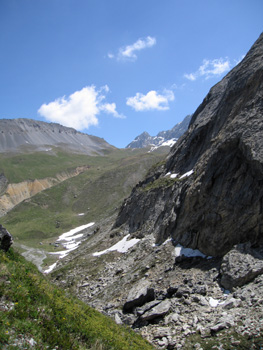 Coming out the forest, a single male Rock Bunting was singing and a pair of Orphean Warblers clucked noisily around the dock-infested clearing high in the forest. The high valley leading to the Refuge de Saut gave us to great views of around 20 Ibex and plentiful Marmots. Sitting for lunch on the steep path overlooking the Roche Pellier, we found Wallcreeper dancing across the limestone faces. Heading further up towards the base of the Glacier de Gebroulax, we saw three Snowfinch, regular Water Pipits and a single Golden Eagle. I also spent an hour convincing myself that I was watching a Lammergeier perched high on a ridge top. Patience revealed it to be a rock!
Coming out the forest, a single male Rock Bunting was singing and a pair of Orphean Warblers clucked noisily around the dock-infested clearing high in the forest. The high valley leading to the Refuge de Saut gave us to great views of around 20 Ibex and plentiful Marmots. Sitting for lunch on the steep path overlooking the Roche Pellier, we found Wallcreeper dancing across the limestone faces. Heading further up towards the base of the Glacier de Gebroulax, we saw three Snowfinch, regular Water Pipits and a single Golden Eagle. I also spent an hour convincing myself that I was watching a Lammergeier perched high on a ridge top. Patience revealed it to be a rock!
We were out for 9 hours during this 15km walk. It was astonishingly beautiful and we saw only three people.
Driving out from Meribel-Mottaret to Moutiers and then north-east on the N90, we found two Alpine Swifts feeding with other Swifts above the L’Isere River below Centron village.
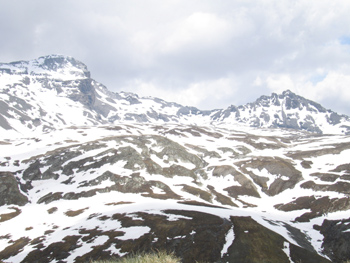
These were the only Alpine Swifts we saw during the fortnight. Red-backed Shrike and Tree Sparrow frequented the arable farmland between the river and the village.
Continuing up the N90, we eventually passed through Val D’Isere and through Le Fornet. On the scree at the valley end, a family party of Chamoix was very approachable. A calling Rock Partridge remained invisible in the scree carpeted by Mountain Avens. A pair of Golden Eagle screamed over us.
Driving further north-east eventually brought us to the 2700 metre pass of the Col de L’Iseran. This is the highest road in the French Alps, giving a breath-taking view over into Italy.
Snowfinch and Water Pipit called from the scree at the roadside.
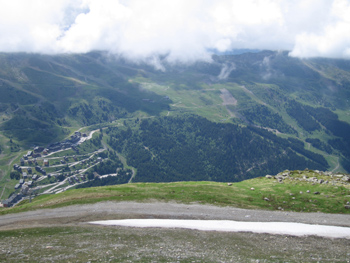
Merribel-Mottaret is an engineered resort, criss-crossed by ski runs and lifts. Much of the mountain vegetation has been lost, cleared to produce good quality ski runs. However, the network of access tracks around and up the valley does make accessing the ridge tops on foot a simple process. Once the ski lifts open for the summer season (4th July onwards), ridge top access in all directions is even more simple.
On the morning of the 18th, we packed up after a tiring but exciting 5 days walking. Heading north through Moutiers and Albertville, we arrived in Doussard at the southern edge of Lac D’Annecy, our base for the next week. We camped at the La Serraz campsite, operated by Eurocamp.
Week 2 Doussard
Having stayed here in 2003 and 2004, this report focuses on some of the new sites and discoveries we made this year. (French Alps Trip Report June 2004)
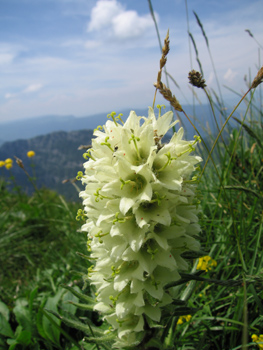 On the 19th, we drove 5km east up the D508 to Marlens and then north up to the track end on the slopes of Mont Charvin. Walking into the forest from the car park proved quiet for birds but we did discover several spikes of Coral Root Orchid, a saprophytic species living on pine roots. A first for me!
On the 19th, we drove 5km east up the D508 to Marlens and then north up to the track end on the slopes of Mont Charvin. Walking into the forest from the car park proved quiet for birds but we did discover several spikes of Coral Root Orchid, a saprophytic species living on pine roots. A first for me!
On the 20th, we drove 10km east up the D508 to Ugine, then headed north up the Col de L’Arpettaz. Two short walks at the summit yielded Rock Thrush, Coal Tit, Northern Wheatear, Buzzard, Cuckoo, Water Pipit and Alpine Chough. Burnt Orchid, Great Yellow Gentian and Globe Flower abounded. Views up to Mont Blanc were also fantastic.
We explored the Cormet de Roselend on the 21st. This 2000 metre road-crossed plateau lies 40km east of Doussard. Snowfinch, Water Pipit, Ring Ouzel and Rock Thrush were seen.
The highlight of week 2 was a rapid ascent of the Col de Colombiere, 30km north of Doussard. Parking at the pass top restaurant, we headed up the mountain, getting immediate close views of 6 Citril Finch seed-feeding above the restaurant. After 15 minutes of climbing, we sat looking up to the summit. Over an hour, we were treated to good distant views of two Lammergeier. This mountain is one of sites where Lammergeier have been reintroduced to the Alps after their extinction during the last century. 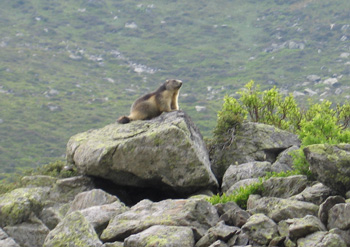 These enormous birds were amazing to see cruising the bleached limestone flanks of the Col. The morning was topped of by another new orchid for me – a lone Musk Orchid spike in a bilberry sheep grazed pasture on the mountain flank. This was a fantastic end to this year’s trip.
These enormous birds were amazing to see cruising the bleached limestone flanks of the Col. The morning was topped of by another new orchid for me – a lone Musk Orchid spike in a bilberry sheep grazed pasture on the mountain flank. This was a fantastic end to this year’s trip.
Bird Species List
| Name | Species | Chambery |
Meribel |
Doussard |
| Great Crested Grebe | Podiceps cristatus | * |
||
| Grey Heron | Ardea cinerea | * |
* |
|
| Mute Swan | Cygnus olor | * |
* |
|
| Mallard | Anas platyrhynchos | * |
||
| Goosander | Mergus merganser | * |
||
| Lammergeier | Gypaetus barbatus | * |
||
| Golden Eagle | Aquila chrysaetos | * |
* |
|
| Black Kite | Milvus migrans | * |
* |
* |
| Comon Buzzard | Buteo buteo | * |
* |
* |
| Honey Buzzard | Pernis apivorus | * |
||
| Sparrowhawk | Accipiter nisus | * |
||
| Kestrel | Falco tinnunculus | * |
* |
|
| Peregrine | Falco peregrinus | * |
||
| Black Grouse | Tetrao tetrix | * |
||
| Rock Partridge | Alectoris graeca | * |
||
| Coot | Fulica atra | * |
||
| Moorhen | Gallinula chloropus | * |
||
| Black-headed Gull | Larus ridibundus | * |
||
| Stock Dove | Columba oenas | |||
| Wood Pigeon | Columba palumbus | * |
||
| Collared Dove | Streptopelia decaocto | * |
* |
|
| Cuckoo | Cuculus canorus | * |
* |
|
| Swift | Apus apus | * |
* |
* |
| Alpine Swift | Tachymarptis melba | * |
||
| Black Woodpecker | Dryocopus martius | * |
||
| Green Woodpecker | Picus viridis | * |
||
| Great-spotted Woodpecker | Dendrocopos major | * |
* |
* |
| Skylark | Alauda arvensis | * |
||
| Sand Martin | Riparia riparia | * |
||
| Crag Martin | Hirundo rupestris | |||
| Swallow | Hirundo rustica | * |
* |
* |
| House Martin | Delichon urbica | * |
* |
|
| Water Pipit | Anthus spinoletta | * |
||
| Meadow Pipit | Anthus pratensis | * |
* |
* |
| Tree Pipit | Anthus trivialis | * |
||
| White Wagtail | Motacilla alba | * |
* |
* |
| Dipper | Cinclus cinclus | * |
||
| Wren | Troglodytes troglodytes | * |
* |
* |
| Dunnock | Prunella modularis | * |
* |
* |
| Robin | Erithacus rubecula | * |
* |
* |
| Nightingale | Luscinia megarhynchos | * |
||
| Black Redstart | Phoenicurus ochruros | * |
* |
* |
| Northern Wheatear | Oenanthe oenanthe | * |
* |
|
| Rock Thrush | Monticola saxatilis | * |
* |
|
| Whinchat | Saxicola rubetra | * |
* |
|
| Song Thursh | Turdus philomelos | * |
* |
* |
| Mistle Thrush | Turdus viscivorus | * |
* |
* |
| Fieldfare | Turdus pilaris | * |
||
| Blackbird | Turdus merula | * |
* |
* |
| Ring Ouzel | Turdus torquatus | * |
* |
|
| Blackcap | Sylvia atricapilla | * |
||
| Orphean Warbler | Sylvia hortensis | * |
||
| Melodious Warbler | Hippolais polyglotta | * |
* |
|
| Willow Warbler | Phylloscopus trochilus | * |
* |
|
| Chiffchaff | Phylloscopus collybita | * |
* |
* |
| Goldcrest | Regulus regulus | * |
* |
|
| Spotted Flycatcher | Muscicapa striata | * |
||
| Great Tit | Parus major | * |
* |
* |
| Coal Tit | Parus ater | * |
* |
|
| Blue Tit | Parus caeruleus | * |
* |
|
| Willow Tit | Parus montanus | * |
||
| Marsh Tit | Parus palustris | * |
||
| Long-tailed Tit | Aegithalos caudatus | * |
* |
|
| Nuthatch | Sitta europaea | * |
* |
* |
| Wallcreeper | Tichodroma muraria | * |
||
| Treecreeper | Certhia familiaris | * |
* |
|
| Red-backed Shrike | Lanius collurio | * |
||
| Magpie | Pica pica | * |
* |
* |
| Jay | Garrulus glandarius | * |
* |
* |
| Nutcracker | Nucifraga caryocatactes | * |
||
| Jackdaw | Corvus monedula | * |
* |
|
| Alpine Chough | Pyrrhocorax graculus | * |
* |
|
| Carrion Crow | Corvus corone | * |
* |
* |
| Raven | Corvus corax | * |
||
| Starling | Sturnus vulgaris | * |
* |
|
| House Sparrow | Passer domesticus | * |
* |
|
| Tree Sparrow | Passer montanus | |||
| Snowfinch | Montifringilla nivalis | * |
* |
|
| Chaffinch | Fringilla coelebs | * |
* |
* |
| Linnet | Carduelis cannabina | * |
* |
|
| Redpoll | Carduelis flammea | * |
* |
|
| Goldfinch | Carduelis carduelis | * |
* |
* |
| Greenfinch | Carduelis chloris | * |
* |
|
| Siskin | Carduelis spinus | * |
* |
|
| Citril Fnch | Serinus citrinella | * |
||
| Serin | Serinus serinus | * |
* |
* |
| Bullfinch | Pyrrhula pyrrhula | * |
* |
* |
| Reed Bunting | Emberiza schoeniclus | * |
||
| Yellowhammer | Emberiza citrinella | * |
||
| Rock Bunting | Emberiza cia | * |
